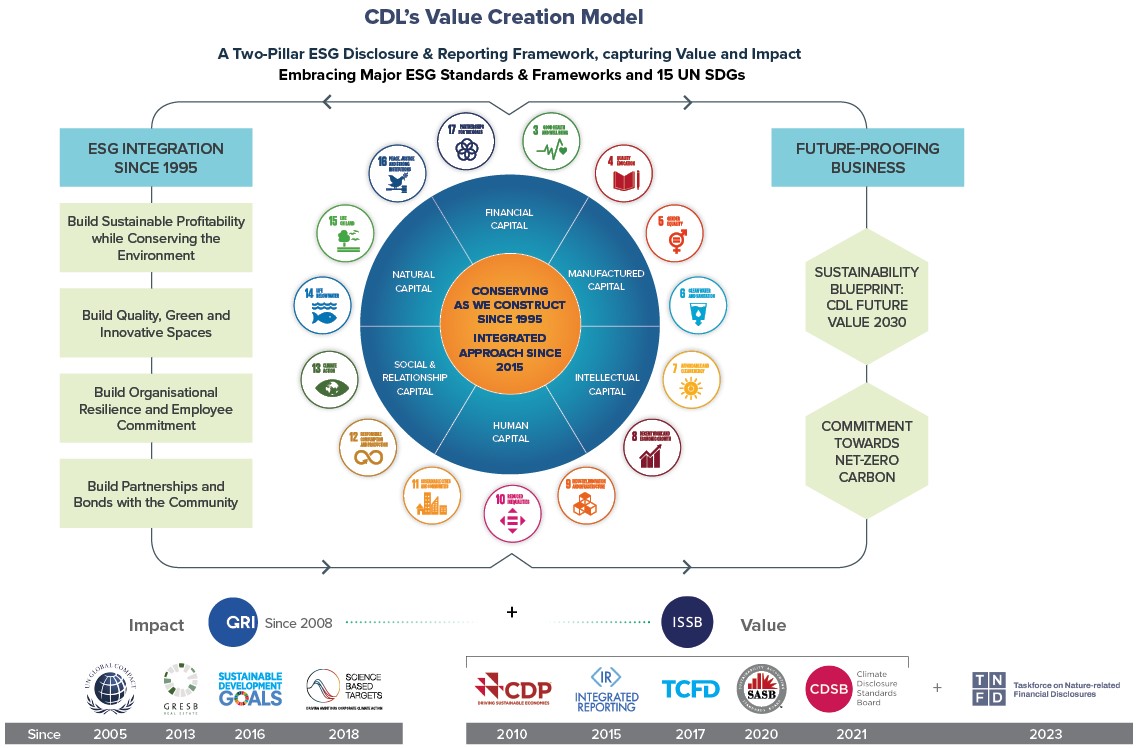ENHANCING VALUE AND IMPACT ON CDL’S ESTABLISHED TRIPLE BOTTOM LINE
Embracing 15 out of 17 UN SDGs since 2016 has sharpened the Company’s sustainability strategy and strengthened our triple bottom line in creating long-term value and future-readiness for our business operations. The Company has been staying on top of global trends including the global race to zero and the call for nature-positive cities and solutions. This has helped us to be well prepared for the rise of investor and consumer activism and more stringent regulations. For nearly three decades, we have firmly believed that the success of businesses is beyond short-term profits. Integrating sustainability is not just about doing good; it has proven to bolster the Company’s resilience, future-proof the business, and ensure financial success through effective risk management.

CDL Value Creation Model – Enhancing Environmental, Social and Economic Sustainability
CDL’s value creation business model is anchored on our ethos of “Conserving as We Construct” since 1995. The model encapsulates our role as a developer, an asset owner and a corporate citizen, and guides us in creating sustained value for our business and stakeholders. Leveraging on six capitals – financial, intellectual, natural, manufactured, human and social & relationship, our business operations and sustainability advocacy is closely aligned with 15 UN SDGs.
What gets measured gets managed. The Company’s robust sustainability reporting has effectively helped the organisation to set targets, track performance, identify gaps for continual improvement to deliver the best results and enhance practices. We have created a unique blended framework using GRI Standards as its core since 2008, adding CDP since 2010, Global Real Estate Sustainability Benchmark (GRESB) since 2013, Integrated Reporting Framework since 2015, SDG Reporting since 2016, TCFD framework since 2017, Science Based Targets initiative (SBTi) since 2018, Sustainability Accounting Standards Board (SASB) Standards and Climate Disclosure Standards Board (CDSB) Framework since 2020. TNFD released its final recommendations in September 2023, providing a framework for organisations to address nature-related risks and opportunities. As biodiversity loss has been highlighted as an existential global threat, the Company has stepped up on our management of nature loss and is the first company in Singapore to report in alignment with the TNFD Recommendations.
Based on our experience in publishing 17 sustainability reports, we support the formation of the ISSB in providing a unified sustainability reporting framework that aims to fulfil the needs of investors and various stakeholders for credible, consistent, and comparable data. We have combined 10 components of our CDL blended reporting framework into two pillars – capturing the “value” and “impact” our business creates. With the launch of the IFRS S1 and S2 in June 2023, the Company has worked with an external consultant on a comprehensive gap analysis to identify the areas for alignment for reporting against IFRS S1 and S2. Moving forward, this will allow us to work towards full alignment and compliance with the ISSB Standards.
External assurance is key to enhance data credibility and instill confidence in stakeholders. External assurance of our sustainability report started in 2009 and has continued to expand. Our Integrated Sustainability Report (ISR) 2022 to ISR 2024’s external assurance has been further elevated in its scope against the GRI Standards, SASB Standards, as well as the TCFD and CDSB frameworks.
Tracking Progress of CDL Future Value 2030 Sustainability Blueprint
Established in 2017, the CDL Future Value 2030 Sustainability Blueprint sets goals for our integrated sustainability strategy towards 2030 — a milestone year for UN SDGs and the net-zero climate agenda. Since July 2017, we have also been voluntarily publishing an online quarterly sustainability report, with our Group CEO as the advisor, to update stakeholders of our progress towards key goals and targets that are set under the Blueprint. Our performance in line with the CDL Future Value 2030 Sustainability Blueprint is detailed in pages 41 to 46 of CDL’s ISR 2023.